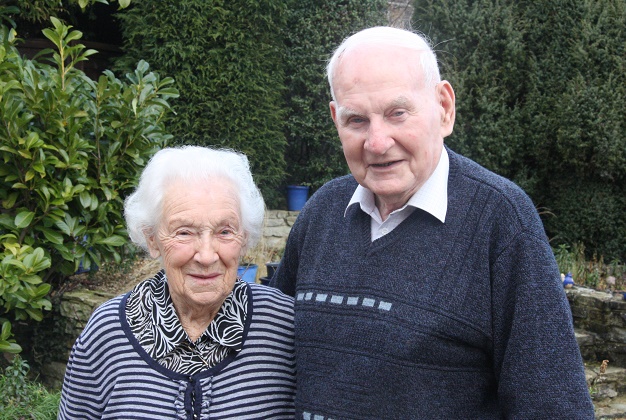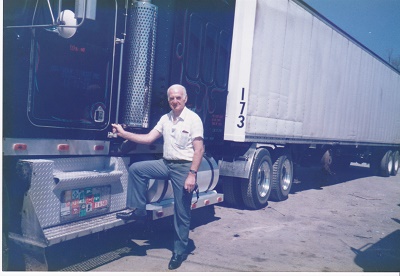During the hundreds of interviews I have conducted in the last 20 years there is one name that has come up time and again as someone who has influenced people: George Taylor. I thought I should go to see him. By Steve Jordan

Until
George retired in 2002 he was the operations director for Michael
Gerson Ltd. His warehouse, and the way in which he ran his operation,
was widely accepted as a model of excellence. The company welcomed
visitors from all over the world to look and learn. But what, exactly,
made George special? I was intrigued.
But as I walked
down the driveway to George and his wife, Olive’s bungalow near Newbury,
the mystery cleared a little. The gardens, all cared for by George and
Olive, are manicured to perfection; the home is pristine (a place for
everything and everything in its place); even the car registration
number ETA 1 gives a clue to the precision on which George thrives.
Even without saying a word, it was clear why his warehouse was world
renowned for its efficiency: George is just made that way.
George
and Olive are true Cockneys: born within the sound of Bow Bells. They
met as youngsters and have now been married for over 60 years. Like
most at that time, George had a basic education, started work at 14 and
learned what he needed to know as he went on. No college certificates
or NVQ’s for George. It was a simpler world then.
His
first job in the moving business was with R. Appleton & Sons. “179
East India Dock Road. Phone number East 3566,” remembered George
illustrating his legendary attention to detail. He was 16 and had
already tried his hand at a few trades, moving on frequently for a
little more money and to comply with the requirement to work as part of
the war effort. ”We weren’t allowed to be out of work in them days. The
money wasn’t much but the tips were good. On a good day you might get
10/- between three of you.” This when £5.00/week was a good wage. He
worked at the company for nearly 19 years.
The company
grew to specialise in what would now be called ‘celebrity’ moves. Alma
Cogan, Shirley Bassey, The Batchelors and Kathy Kirby were all George’s
customers. Unfortunately the company fell into difficulties when one of
the two brothers who owned it died early. The second brother took the
loss very badly and stepped away from the business leaving George and
the crew to get on with it. It caused tension when he returned three
years later.
George recalls the last straw. He was
moving The Batchelors when the piano player, who was known to be
temperamental, criticised George’s piano handling. “I told him, if you
want this piano moved you can move it yourself. Then I left.”
When
he arrived home Olive couldn’t believe him. “She thought I was mad to
give up the job,” said George. But he wasn’t the kind to put up with
fools, customers or not. He’d had enough of the moving trade when he
spotted an advert in the Evening News for export packers. Michael Gerson had just started his company in Finchley.
 George
was paid £12.10s a week. Harry Hall was warehouse manager, Ted Grimes
the Foreman, and the Directors were Colin Gordon and Michael himself
with Pat providing secretarial support. It was a challenge, starting
from scratch, but George’s combination of hard work and ingenuity meant
that he was soon making his impact. George bought a Ford Thames 15cwt
van to carry materials long before the company had its own fleet. “It
saved us having to travel to jobs on the bus,” said George.
George
was paid £12.10s a week. Harry Hall was warehouse manager, Ted Grimes
the Foreman, and the Directors were Colin Gordon and Michael himself
with Pat providing secretarial support. It was a challenge, starting
from scratch, but George’s combination of hard work and ingenuity meant
that he was soon making his impact. George bought a Ford Thames 15cwt
van to carry materials long before the company had its own fleet. “It
saved us having to travel to jobs on the bus,” said George.
The
business grew. George bought a bigger van. They used lift vans for
moves to destinations around the world; BD and BK railway containers for
France and Germany; and 5,000 cu ft Ferry Wagons for Scandinavia.
Eventually, as George’s van became older, Michael bought a 500 cu ft van
for George to use. The Michael Gerson fleet was born.
In
1973 George came in off the road to be warehouse manager and helped to
introduce the company to palletisation. “We found some containers for
sale at Brewer and Turnbull in Peacehaven. They were strong but were
all nailed. We spent two weeks dismantling them with nail drawers,
moving them to Finchley and assembling them again.”
The Iron Lady, who’s not for moving,
Needs her pre-move nerves a soothing,
We’ve got the move, of that no doubt,
So we let George sort that one out.
George
said he couldn’t see the point of containerised storage unless they
were loaded at residence. “So we put them on flat bed trailers, loaded
them on site and put them straight in the warehouse. This had never
been done before.” This set the scene for all that George did. He would
continually say to himself: “There must be a better way to do this.”
Often, there was.
One night they pulled a vehicle in the
yard and the sheets were blowing everywhere. It was pouring with rain.
“So I contacted Southfields body builders,” said George. “I sked if
they could convert a Leyland vehicle we had into a curtain sider.” This
was another ‘first’. Another classic tool for movers was born. George
also had the yard cut out to create a loading ramp and made a side
entrance in the warehouse so cars could be driven straight into the
container. All new ideas at the time.
Around that
time, and not being entirely happy with the first batch of containers,
George started working with Fred Shea from Sumacon Luralda to develop
something better (see interview with Roy Church, The Mover,
January 2015). Together they perfected the clipped 380 cuft container
that provided extra space unlike the 270 cuft version used by most
movers. “And we made them strong so they could be stacked. One weekend I
put four tonne or more weight on one and left it in the middle of the
warehouse. I figured if it was still square on Monday it would be OK. It
was.”
George introduced racking into the warehouse,
long before anyone else had thought of it, to keep the materials tidy.
And, following a trip to American with Colin Gordon in 1974, he noticed
the wasted space above the loading doors in the warehouse. “When we came
back I had mezzanine floors built above the doors in our new Whetstone
warehouse to provide a packing and inspection area and to store cars.”
George gave the following advice to me,
I think it was in nineteen ninety three,
If your ear you don’t want me to bend
Wash your car at the weekend
He
was innovating all the time. Whenever he had a problem he would think
it through carefully. There was always a better way. Most noticeable
was the introduction of cartons to replace T-chests and paper blankets
to replace brown paper and corrugated for packing – both ideas from the
US trip. UK manufacturers weren’t making them at that time.
When
George became the company’s operations director, his focus switched
from just the warehouse to the whole organisation of the company’s work.
He had a knack of being able to motivate people. He never took an
office in the main block, preferring to stay in the warehouse, closer to
the action. He made sure everyone understood what they had to do and
supported them all the way. If there was a tricky job, George was
there, taking charge. And the men respected him because they knew he had
done it all.”
George is a member of the RHA
He goes to their meetings to have his say,
And if the meeting gets rather boring,
You may find him at the back, quietly snoring.
George
said it was seldom that anything went wrong which was, undoubtedly,
owing to his meticulous planning. Vehicles were always kept clean and
painted and they all had private numbers (Michael’s idea) so the age
wasn’t obvious. They each had their designated parking spots in the
yard. Everything had to be in its place. “As long as people understood
why I wanted things done my way, they were happy. I never had any
problem with anyone.”
George left Michael Gerson the day
after the Management Buy Out, 19 December, 2002 after around 60 years
in the industry. He still had offers of work, but didn’t accept them.
He always did things his way, the better way, and he was influenced by
nobody except Michael Gerson himself who he describes as “a remarkable
man”. He was loved and respected by his staff, a relationship that was
illustrated by the mounted poem with which they presented him when he
left, some stanzas of which are repeated here.
The last large move George oversaw,
Was the movement of 16,000 guns or more,
All packed up without a fault,
And moved under police escort.
George
was one of the real characters of the moving industry; a breed that
seems to be lacking nowadays. But look a little closer and you can see
why. He spent much of the Blitz in London; was evacuated for a short
while to Swindon; lived through a V2 attack that blew the back out of
his house; blagged a job as a cabin boy on a cargo ship at 13 and sailed
twice between Boston and Murmansk before the captain paid him off
because too many ships had been lost to U-Boats; turned his hand to
whatever job came along to make a shilling; and had the courage not to
suffer fools. He did more living before he was 20 than many do now in a
lifetime. That’s why George and his generation produced so many
colourful characters the like of which we may never see again.
He’s
87 now and he and Olive have been married for 64 years. The moving
industry has allowed them to make lifelong friends and travel the world.
It’s been good to them. But nobody could deny, George has been pretty
good for the industry too.
Photo: George and Olive at home; George at a Sear's warehouse complex in Kansas City
Click here to view the next Editor's pick.